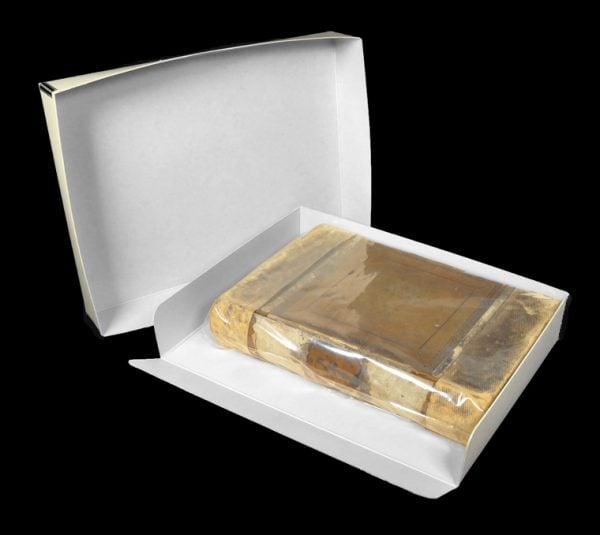This ledger dates from 1832—when Andrew Jackson was President and Abraham Lincoln was only 23 years old! It has been in the owner’s family for over 185 years, so it has significant personal value. We’re going to show you the simple steps involved in archivally preserving old books like this, and explain the basic differences between archival preservation and conservation.
One of the primary differences between archival preservation and conservation boils down to protecting an object versus repairing an object. We’ll cover the easy steps involved in archival preservation to make sure this book continues to survive intact.
Comparing the front and back of this ledger reveals the challenges of preserving old books, as the fire damage on the book’s back might suggest the need to call in a trained conservator.
At some point this book survived a serious fire, and the resulting fire damage has actually become an integral part of this book’s history.
While a trained conservator could undoubtedly repair a great deal of this damage, the damage is part of the object’s story and has become part of the family’s history.
To keep this history intact, the book is going to be archivally preserved (maintained by the owner in its current state in a safe archival bag and an acid-free box), but not conserved (professionally repaired by a trained conservator).
Here are the steps you can take to preserve books in your collection.
1.) Use a dry, soft, clean cloth or sable brush to gently clean the book before archivally storing it. Make sure your hands are clean and dry before you handle this project. You can opt to wear cotton gloves or nitrile gloves to keep unwanted finger oils off of old artifacts and documents.
2.) Place the book in a polyethylene bag to protect it from dust, dirt, and potential liquid spills, and just fold over any excess bag. Don’t seal the bag since books need to “breathe” as they expand and contract with temperature and humidity fluctuations.
3.) Place the book in an acid-free Metal Edge Box that will add another level of archival protection during storage and handling. Choosing a box that is close to the book’s size helps to keep it from sliding around during handling. If there is extra space in the box use crumpled Archival Tissue to cushion the book within the box.
In the case of this book, because of the fire damage, it is best to store it by itself in order to not contaminate other books or artifacts that might be stored with it. This holds true for any musty smelling books you might have in your collection.

4.) The last step is to find a suitable place to keep the box. A shelf in a closet within one’s living space is one of the best home storage locations. It’s dark and generally climate controlled. Never store valued collections in basements, attics, or garages. Temperature and humidity fluctuations are bad for artifact storage. These spaces are also more prone to pest infestations, leaks, and flooding.
Consider using Adhesive Back Vinyl Labels to identify the contents of your boxes. Here is a blog post about creating finding aids for your storage boxes.
Having survived for over 185 years, this family artifact is now ready for the next century. It’s archivally safe and easily accessible—exactly what you want when preserving old books in your collection.
Contact Us
If you have any additional questions, or would you like more information on any of our museum-quality acid-free storage and presentation materials, please contact us here at Archival Methods. We’re always there to help with any archiving, storage, or presentation questions you may have.
*this blog post was updated on January 4, 2023




